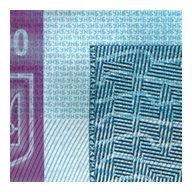Relief feature
Element for the partially sighted, which is rough to the touch
Image of Volodymyr Vernadskyi
The main image on the front of the note is a portrait of Volodymyr Vernadskyi
Image of the Presidium of Ukraine’s National Academy of Sciences
The central design element on the back of the note
Image of the Presidium of Ukraine’s National Academy of Sciences
The central design element on the back of the note

See-through register
A complete image of the denomination that appears when the note is held up to the light
See-through register
A complete image of the denomination that appears when the note is held up to the light
SPARK feature
When looked at from different angles, some elements of the banknote generate a dynamic light effect – the ink in some areas gradually changes color from gold to jade green
SPARK feature
When looked at from different angles, some elements of the banknote generate a dynamic light effect – the ink in some areas gradually changes color from gold to jade green
Window thread
The thread features the denomination “1,000” and Ukraine’s small coat of arms. When looked at from different angles, the thread produces a dynamic light effect
Window thread
The thread features the denomination “1,000” and Ukraine’s small coat of arms. When looked at from different angles, the thread produces a dynamic light effect
Volodymyr Vernadskyi, one of Ukraine’s most famous scientists, was one of the few polymaths of the last century, both a thinker and a natural scientist.
Vernadskyi was the founder of the scientific fields of geochemistry and radiogeology. He also pioneered biogeochemistry and was a seminal teacher of the concepts of the biosphere and the noosphere.
He won multiple awards for his contributions to global science, and was appointed a member of international academies of sciences and scientific societies.
Vernadskyi also had the honor of co-founding and becoming the first president of the Ukrainian Academy of Sciences.
“You know how dear Ukraine is to me, and how deeply the rebirth of Ukraine is engrained in my national and personal worldview,” Vernadskyi wrote in his memoirs.
I believe in a great future for Ukraine


 Watermarks
Watermarks

A multi-tone watermark depicting a portrait of Volodymyr Vernadskyi and a light watermark element in the form of the denomination figure (in the bottom right part of the multi-tone watermark)
 Embedded security thread
Embedded security thread

The thread has transparent images, an ultraviolet feature and a magnetic code
 Window thread
Window thread

The thread features the denomination “1,000” and Ukraine’s small coat of arms. When looked at from different angles, the thread produces a dynamic light effect – the background image moves in a different direction
 SPARK feature
SPARK feature

When looked at from different angles, some elements of the banknote generate a dynamic light effect – the ink in some areas gradually changes color from gold to jade green
 See-through register
See-through register

A complete image of the denomination “1,000” appears when the note is held up to the light
 Latent image
Latent image

The denomination “1,000” becomes visible and changes color from light to dark when the note is held at a sharp angle to the light
 Relief features
Relief features

Image elements that are rough to the touch:
 Microlettering
Microlettering

Repeated legends that can be read under a magnifying glass

Useful link
for downloading
 When will the NBU issue the new highest-denomination 1,000 hryvnia banknote into circulation?
When will the NBU issue the new highest-denomination 1,000 hryvnia banknote into circulation?
On 25 October 2019.
 Why did the NBU decide to issue a new denomination into circulation at this particular time? Is this related to inflation?
Why did the NBU decide to issue a new denomination into circulation at this particular time? Is this related to inflation?
In deciding to issue new denominations into circulation, central banks take into account economic factors, such as the size and changes in the average wage, the number of banknotes in circulation, the share of cashless payments, the inflation rate, and the need to improve security features.
The 500 hryvnia banknote was issued into circulation in 2006. At that time, the average monthly wage was about UAH 1,000, payable with two highest-denomination banknotes.
The size of the Ukrainian economy has changed since then: the income of Ukrainians has increased, with the average monthly wage rising by almost nine times. Today, in order to pay out the average monthly wage, at least 20 banknotes are required.
As a result, the amount of cash in circulation has increased by over five times, to almost UAH 380 billion. Therefore, higher-denomination banknotes are required to meet the cash needs of the growing economy.
The issue of the new banknote will make payments for households and businesses more convenient, and help decrease the banks’ operating expenses and collection costs.
It will also reduce the NBU’s expenses related to the printing, storage, processing and transportation of banknotes.
 Did the central bank conduct any analysis to justify the launch of the new denomination?
Did the central bank conduct any analysis to justify the launch of the new denomination?
The NBU used the D-metric model to analyze the structure of hryvnia banknote denominations. According to this model, the highest denomination banknote should approximate to the average daily wage for two days. Since the average wage in Ukraine already exceeds UAH 10,000 and is continuing to rise, this figure is gradually approaching that of the new denomination.
Another analysis also proves the need to launch a new denomination. 500 hryvnia banknotes currently account for the largest share of banknotes in circulation, at over 55%. Going by global experience, the 50% threshold is indicative of the need for a higher denomination.
 Is the introduction of the new banknotes related to the large number of counterfeits?
Is the introduction of the new banknotes related to the large number of counterfeits?
No. Hryvnia banknotes incorporate high-level security features, on a par with those of the world’s leading currencies. The number of counterfeit hryvnia banknotes withdrawn from circulation remains consistently low.
In 2018, there were approximately 2.5 counterfeit banknotes per million authentic hryvnia banknotes. The NBU was able to achieve such results by constantly upgrading security features – just as the world’s leading central banks do – in order to be a step ahead of counterfeiters, preventing them from counterfeiting hryvnia banknotes.
 How many new 1,000 hryvnia banknotes have already been printed?
How many new 1,000 hryvnia banknotes have already been printed?
The printing of the banknote will begin in accordance with the production schedule of the Banknote Printing and Minting Works. The NBU initially plans to print and issue approximately five million 1,000 hryvnia banknotes into circulation.
 Will the new banknotes be available in ATMs from 25 October onwards?
Will the new banknotes be available in ATMs from 25 October onwards?
Yes. The NBU will start supplying the new banknotes to banks across all regions on 25 October 2019, meaning that the banks will be able to issue them to their customers that day.
The NBU presented the new banknote four months prior to its official issue date – 25 October 2019 – to give the banks enough time to reprogram their equipment (such as ATMs and self-service kiosks), while giving households time to learn about the design and security features of the new banknote.
 Why did the NBU choose to depict Volodymyr Vernadskyi on the new note?
Why did the NBU choose to depict Volodymyr Vernadskyi on the new note?
Ukrainian banknotes have always featured either outstanding public figures (Bohdan Khmelnytskyi, Mykhailo Hrushevskyi and Volodymyr the Great) or famous writers and artists (Hryhorii Skovoroda, Lesia Ukrainka, Ivan Franko and Taras Shevchenko).
The NBU conducted detailed research before choosing the Ukrainian scientist for its new banknote. To that end, the central bank held consultations with the History Institute of the National Academy of Sciences, the Ministry of Culture and the National Memory Institute.
One name was suggested by all of these institutions – that of Volodymyr Vernadskyi, a famous Ukrainian scientist, and the co-founder and first president of Ukraine’s Academy of Sciences.
Vernadskyi rose to international fame as a unique philosopher, global thinker, natural scientist, and the founder of the scientific fields of geochemistry, biogeochemistry and radiogeology. Vernadskyi’s life was closely connected to Ukraine. He was a patriot of Ukraine and foresaw a happy future for his nation, destined to take its rightful place in Europe and in the world.
 How significant is Volodymyr Vernadsky’s contribution to science?
How significant is Volodymyr Vernadsky’s contribution to science?
Vernadsky is rightly numbered among the ”encyclopedic scientists.” He made discoveries in at least 12 sciences: crystallography, geology, radiogeology, meteoritics, paleontology, soil science, biogeochemistry, mineralogy, geochemistry and biology, and also in philosophy and history. He actually laid the foundations of some scientific fields – biogeochemistry, geochemistry and nuclear geology.
In 1918, Vernadsky was elected as the first president of the Ukrainian Academy of Sciences. In this position, and later as president of the Tavrida University, he proved himself not only to be a talented scientist, but also a remarkable manager of the scientific process. From its very beginnings, the academy consisted of 45 establishments: 15 institutes, 14 standing commissions, 6 museums, 2 offices, 2 laboratories, botanical and acclimatization gardens, an astronomical observatory, a biological station, a library, a printing house, and archives. When speaking in Paris on the results of his work and research in 1918–1919, his speech caused a sensation.
Moreover, Vernadsky founded the National Library of the Ukrainian State in Kyiv, the Radium Institute, Biochemical Laboratory, Laboratory for Studying Radioactive Minerals, and the Department of Living Matter, and was a co-founder of the Productive Forces Council.
Among other things, the scientist maintained close ties with the international scientific community, and often gave lectures in French, German, and English. In 1888, he underwent training in Italy, Germany, Austria, France, England and Switzerland. He also worked at European laboratories of chemistry and crystallography, and participated in the London Geological Congress. In 1922–1926, at the invitation of the Sorbonne University, Vernadsky gave lectures on geochemistry in Prague and Paris, and conducted research at the Curie Laboratory in France. He was also elected an associate fellow of the British Association for the Advancement of Science.
 What other historical figures were proposed?
What other historical figures were proposed?
The suggestions included the historian Mykola Kostomarov, the writer Oleksandr Dovzhenko, Prince Danylo of Halych, and the hetmans Petro Konashevych-Sahaidachnyi and Pavlo Skoropadskyi.
 How long did it take the NBU to design the new banknote?
How long did it take the NBU to design the new banknote?
Slightly over a year. During that time, the central bank also developed the security features of the note, and addressed logistical issues.
 Who designed the new banknote?
Who designed the new banknote?
The NBU has a complete cycle of banknote production. Since this activity is confidential, currently only the staff of the NBU Banknote Printing and Minting Works design banknotes and decide what security features to incorporate. This is a team of ten experienced designers who possess all of the required knowledge and skills. Each of them is responsible for a particular design element or security feature, such as the portrait, ornaments or the numerical indications of the denomination.
 Whose signature will feature on the banknotes?
Whose signature will feature on the banknotes?
Under Ukrainian law, the banknotes must bear the signature of the incumbent NBU Governor. Thus, the 1,000 hryvnia banknotes designed in 2019 will feature the signature of Yakiv Smolii.
...